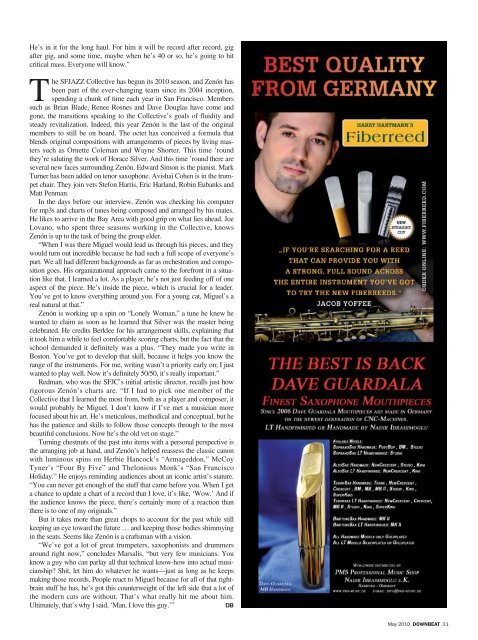Download - Downbeat
Download - Downbeat
Download - Downbeat
- No tags were found...
Create successful ePaper yourself
Turn your PDF publications into a flip-book with our unique Google optimized e-Paper software.
He’s in it for the long haul. For him it will be record after record, gigafter gig, and some time, maybe when he’s 40 or so, he’s going to hitcritical mass. Everyone will know.”The SFJAZZ Collective has begun its 2010 season, and Zenón hasbeen part of the ever-changing team since its 2004 inception,spending a chunk of time each year in San Francisco. Memberssuch as Brian Blade, Renee Rosnes and Dave Douglas have come andgone, the transitions speaking to the Collective’s goals of fluidity andsteady revitalization. Indeed, this year Zenón is the last of the originalmembers to still be on board. The octet has conceived a formula thatblends original compositions with arrangements of pieces by living masterssuch as Ornette Coleman and Wayne Shorter. This time ’roundthey’re saluting the work of Horace Silver. And this time ’round there areseveral new faces surrounding Zenón. Edward Simon is the pianist. MarkTurner has been added on tenor saxophone. Avishai Cohen is in the trumpetchair. They join vets Stefon Harris, Eric Harland, Robin Eubanks andMatt Penman.In the days before our interview, Zenón was checking his computerfor mp3s and charts of tunes being composed and arranged by his mates.He likes to arrive in the Bay Area with good grip on what lies ahead. JoeLovano, who spent three seasons working in the Collective, knowsZenón is up to the task of being the group elder.“When I was there Miguel would lead us through his pieces, and theywould turn out incredible because he had such a full scope of everyone’spart. We all had different backgrounds as far as orchestration and compositiongoes. His organizational approach came to the forefront in a situationlike that. I learned a lot. As a player, he’s not just feeding off of oneaspect of the piece. He’s inside the piece, which is crucial for a leader.You’ve got to know everything around you. For a young cat, Miguel’s areal natural at that.”Zenón is working up a spin on “Lonely Woman,” a tune he knew hewanted to claim as soon as he learned that Silver was the master beingcelebrated. He credits Berklee for his arrangement skills, explaining thatit took him a while to feel comfortable scoring charts, but the fact that theschool demanded it definitely was a plus. “They made you write inBoston. You’ve got to develop that skill, because it helps you know therange of the instruments. For me, writing wasn’t a priority early on; I justwanted to play well. Now it’s definitely 50/50, it’s really important.”Redman, who was the SFJC’s initial artistic director, recalls just howrigorous Zenón’s charts are. “If I had to pick one member of theCollective that I learned the most from, both as a player and composer, itwould probably be Miguel. I don’t know if I’ve met a musician morefocused about his art. He’s meticulous, methodical and conceptual, but hehas the patience and skills to follow those concepts through to the mostbeautiful conclusions. Now he’s the old vet on stage.”Turning chestnuts of the past into items with a personal perspective isthe arranging job at hand, and Zenón’s helped reassess the classic canonwith luminous spins on Herbie Hancock’s “Armageddon,” McCoyTyner’s “Four By Five” and Thelonious Monk’s “San FranciscoHoliday.” He enjoys reminding audiences about an iconic artist’s stature.“You can never get enough of the stuff that came before you. When I geta chance to update a chart of a record that I love, it’s like, ‘Wow.’ And ifthe audience knows the piece, there’s certainly more of a reaction thanthere is to one of my originals.”But it takes more than great chops to account for the past while stillkeeping an eye toward the future … and keeping those bodies shimmyingin the seats. Seems like Zenón is a craftsman with a vision.“We’ve got a lot of great trumpeters, saxophonists and drummersaround right now,” concludes Marsalis, “but very few musicians. Youknow a guy who can parlay all that technical know-how into actual musicianship?Shit, let him do whatever he wants—just as long as he keepsmaking those records. People react to Miguel because for all of that rightbrainstuff he has, he’s got this counterweight of the left side that a lot ofthe modern cats are without. That’s what really hit me about him.Ultimately, that’s why I said, ‘Man, I love this guy.’”DBMay 2010 DOWNBEAT 31
















